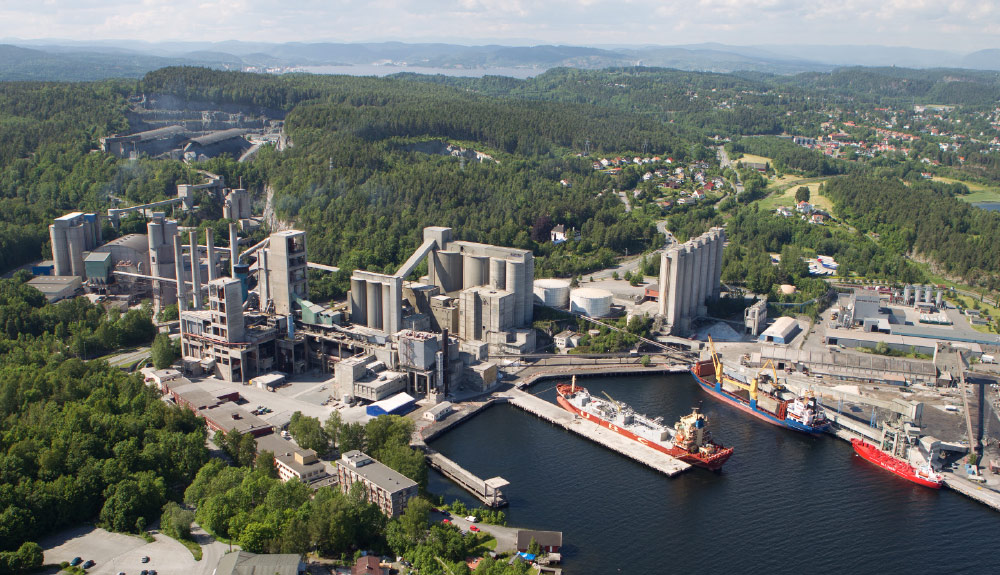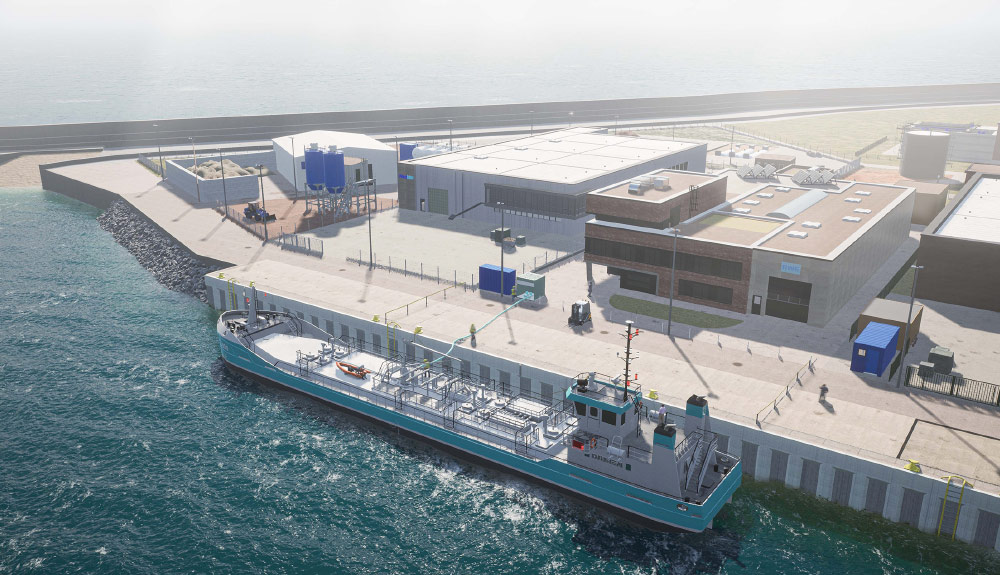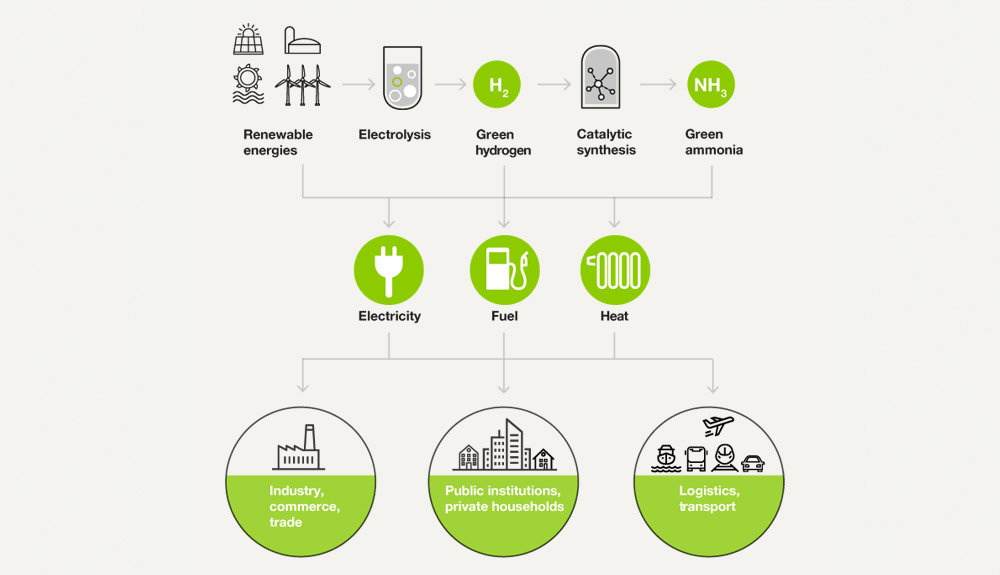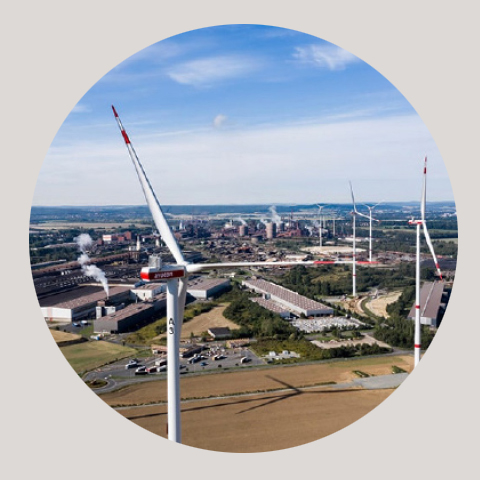Green Gases
The importance of green hydrogen for the energy transition is undisputed. Now on the agenda is the production and application of ammonia as the second green gas. For both, Mannesmann Line Pipe already has products and solutions ready for use today: for efficient transport, safe storage and carbon-neutral application.
Renewable power generation continues to struggle with two serious problems: volatility in its production and timely cost-effective distribution over a wide area. Both problems can be solved with green hydrogen. Study findings and research projects have now spawned large-scale projects.
Production on the industrial scale
Numerous big-name industrial companies, plant manufacturers and energy companies are devoting themselves to the production and application of green hydrogen. On the site of Energy and Chemicals Park Rheinland in Wesseling near Cologne, for example, Europe’s largest PEM electrolyzer for the production of green hydrogen went into operation in the summer of 2021. The 10 megawatt plant will produce up to 1,300 metric tons of green hydrogen per year, and a 100 MW plant is already in the pipeline. Industrial gas producer Linde is set to commission a 24 MW project in Leuna in 2022. BP and Ørsted, world market leader in offshore wind energy, are jointly planning a 50 MW electrolysis plant on the site of the BP refinery in Lingen. And Siemens Smart Infrastructure has also entered the green hydrogen production market by teaming up with “Wun H2” to produce up to 1,350 tons of green hydrogen annually in Wunsiedel, Bavaria from mid-2022. The AquaVentus project aims to produce green hydrogen at sea, right where the energy for it is generated. Electrolysis plants with a total volume of 10 gigawatts are planned by 2035 and would be capable of producing up to 1 million tons of green hydrogen and distributing it via pipelines.

Award-winning hydrogen production: Europe’s largest PEM electrolyzer for the production of green hydrogen in Wesseling received an award from EnergyAgency.NRW as an ‘innovative climate protection project’.
Image: © Shell

"And just as for the cost-effective transport, safe storage and carbon-neutral application of hydrogen and ammonia as green gases, a wide range of products is also available to our customers in the field of carbon capture and transport."Konrad Thannbichler, Mannesmann Line Pipe Head of Sales
Salzgitter AG – green hydrogen for green steel
Salzgitter AG is already moving into concrete application mode with green hydrogen. In addition to a PEM electrolyzer, Salzgitter AG operates the world’s largest high-temperature electrolyzer, using the waste heat from steam from steel production. In this way, the first green steel components are already being produced today and are used, for example, by Miele and Mercedes-Benz AG.
Hydrogen versus ammonia
But alongside numerous advantages, hydrogen also has its drawbacks. And this is where ammonia takes its cue. Ammonia is the world’s second-most common basic chemical, a compound of nitrogen and hydrogen. Until now, 80% of ammonia has been used as a fertilizer, but because it is combustible, it could also be used as an energy source in fuel cells. It burns to form nitrogen and water and, in its pure form, is not itself a climate gas. Ammonia has several advantages over hydrogen, one of them being that it liquefies at -33°C, compared to hydrogen only at -253°C. Its vapor pressure at 20°C is only 8.6 bar. In addition, it has a significantly higher energy density than hydrogen, ignites less readily and is less explosive. The gas is therefore comparatively easy to liquefy, trans-port and store.
But the production of ammonia is also highly energy-intensive. Green ammonia is produced by catalytic synthesis from separated atmospheric nitrogen and green hydrogen and loses efficiency in the process. In the electrolysis of hydrogen from wind or solar power, the efficiency is 70 to 90%, depending on the process. Due to the conversion to ammonia, the overall efficiency through to conversion back into electricity – in a steam power plant, for example – is then only 55 to 60%. So in fact it makes more economic sense to use renewable energy directly or to store it in the form of green hydrogen. However, ammonia scores with its simpler handling, transport and storage. This could be of benefit to shipping, for example, which currently mainly uses bunker fuel – the cheapest and most harmful fossil fuel of all.

In Brevik, Norway, HeidelbergCement is to build the world’s first industrial-scale carbon capture and storage facility in a cement plant. The plant is scheduled to go into operation in 2024 and capture around 400,000 tons of carbon per year.
Image: © HeidelbergCement/Norcem
Hydrogen transport via natural gas pipeline
Germany has a 50,000 km high-pressure natural gas network. Utilizing this existing infrastructure would enable a prompt and smooth transition to a decarbonized heating sector. Especially when one considers that the natural gas distribution network across the country as a whole is even about 500,000 km long.
In the European context, Germany’s National Hydrogen Council* (NWR) therefore sees hydrogen transport by pipeline as the most economical option for distances of up to 10,000 km. Other advantages are that the use of existing infrastructure would reduce system costs and accelerate implementation, and social acceptance would certainly be very high.
Initial tests have yielded very promising results. For example, E.ON subsidiary Avacon is testing the admixture of hydrogen in a subnetwork in Saxony-Anhalt. Together with the German Technical and Scientific Association for Gas and Water (DVGW), the company wants to demonstrate that it is technically possible to feed a percentage of hydrogen significantly higher than previously envisaged into an existing gas network. Equipment and plant do not have to be modified in the first step of this process.
New distribution networks already being planned
The purpose of the “H2.Ruhr” infrastructure project is to set up a distribution network in order to supply municipal, medium-sized and industrial companies in the Ruhr region with carbon-free hydrogen and green ammonia. By 2032, up to 80,000 tons of hydrogen per year is to be made available to regional customers between Duisburg and Dortmund.
Hydrogen storage in caverns
The total capacity for injection and withdrawal at German gas storage facilities is around 23 billion cubic meters of gas. Whether and how these storage facilities can also be used for hydrogen storage is being investigated in a pilot project run by the energy utility EWE AG. The safe storage of 100% hydrogen is to be tested and demonstrated in a 500 m³ cavern in the salt dome in Rüdersdorf, Brandenburg. Findings from the project could then be scaled up to large cavern storage facilities.

As part of the AquaVentus project, Helgoland is to become a carbon-neutral hydrogen hub in the North Sea and the starting point for a liquid organic hydrogen carrier (LOHC) supply chain.
Visualization: © Jakob Martens/ TransHyDE Projekt Helgoland
Keeping carbon capture and storage in mind
As green gases, hydrogen and ammonia will clearly play an indispensable role in the success of the energy transition. But carbon capture and storage (CSS) will also be a big factor in the decarbonization of the industrial and energy sectors. With CSS, it will be possible to capture and permanently store up to 95% of the carbon emissions generated by the burning of fossil fuels for power generation and in industrial processes.
The technical processes are proven and are suitable for practical use. In Brevik, Norway, HeidelbergCement will build the world’s first industrial-scale carbon capture and storage facility in a cement plant. Starting in 2024, 400,000 tons of carbon dioxide will be captured annually and transported for permanent storage. This would reduce carbon emissions from the cement produced at the plant by 50%.
This is why Mannesmann Line Pipe Head of Sales Konrad Thannbichler says: “We must not lose sight of the issue of carbon capture as we continue to drive forward the energy transition. It’s all technically possible. And just as for the cost-effective transport, safe storage and carbon-neutral application of hydrogen and ammonia as green gases, a wide range of products is also available to our customers in the field of carbon capture and transport.”
*The National Hydrogen Council acts as an independent, non-partisan advisory body. 25 senior experts assist and advise the State Secretary’s Committee for Hydrogen on the further development and implementation of the National Hydrogen Strategy.
Importance of renewable energies and green gases for the energy transition
Mannesmann H2ready®
The mechanical and technological properties of our steel pipes, specially developed and qualified for the transport of hydrogen, exceed the requirements of the EIGA guideline.
Efficient transport
Safe storage
Carbon-neutral application
For long-term resistance to transported hydrogen, the inner surface is supplied free of surface offsets (in compliance with ISO 3183). Furthermore, any internal points of attack for the hydrogen are minimized by guaranteeing phosphorus and sulfur levels lower than those specified in the EIGA guideline. The also further reduced carbon equivalent ensures excellent weldability. For greater freedom of pipeline design, we offer grades up to X70 (according to API 5L) and L 485. If required for the order, a material’s suitability for the hydrogen atmosphere can be proven in a comparative test.
Salzgitter AG makes steelmaking green
With its SALCOS® climate project, Salzgitter AG has laid the foundations for the virtually zero-carbon steel production of the future. Green hydrogen will replace the coal currently used in the conventional blast furnace process.
Salzgitter AG has erected seven wind turbines on the Group’s site in Salzgitter for the production of green hydrogen by PEM electrolysis. These are joined by a highly efficient high-temperature electrolyzer that recovers the waste heat from the steam from steel production.
Together, the two facilities can already meet the hydrogen requirements for annealing processes and steel refining, replacing gray hydrogen produced with natural gas.
However, further large quantities of green hydrogen will be needed. The new technology strategy involves gradually replacing the existing blast furnaces with direct reduction plants. In this process, iron ore is reduced with the aid of hydrogen into sponge iron (almost pure iron). Instead of carbon dioxide, this produces water (H2O), which in turn is reused in the integrated process. Finally, to produce steel, the porous sponge iron is finally melted down with steel scrap in an electric arc furnace.
Salzgitter AG’s first direct reduction plant could go into operation in 2026. Overall carbon emissions in steel production can be reduced by more than 95% with the new technological approach.
Subsidiaries of Salzgitter AG are now already producing steel in a carbon-reduced process. Since November 2021, the Miele domestic appliance group has been processing just under 24 tons of carbon-reduced steel per month as part of a pilot project in the cooker and oven sector. Since 2021, Salzgitter AG Group subsidiary Salzgitter Flachstahl GmbH has been supplying green flat steel products with a more than 66%-reduced carbon footprint to four German Mercedes-Benz AG plants. And from 2026, carbon-reduced steel is to be supplied to all BMW Group plants in Europe and the Volkswagen plant in Wolfsburg.


